| Introduction |
Since the last Podcaster, N2Africa was show-cased at the Joint Pan-African Grain Legume and World Cowpea Conference in Livingstone, February 28 – March 4. N2Africa was well represented; we funded 53 participants, presented 15 posters and 3 talks and led a special session on Grain legume nitrogen fixation and contributions to sustainable intensification. It was a great opportunity to get up to date on all of the great research going on around the world with a special emphasis on Africa. Also a real opportunity for networking and forging new collaborations with a wider community of researchers. Many thanks to all staff and partners who ...
|
1 |
| Reflections after the Pan-African Grain Legume & World Cowpea Conference in Zambia - A perspective on value chain partnerships from Rebbie Harawa (AGRA) |
|
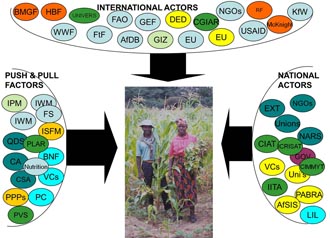
|
Listening to presentations for almost a week at the Joint Pan-African Grain Legume and World Cowpea Conference early this year, it was clear that there a lot of efforts that are going on the African continent that are geared towards intensifying legume production for smallholder farmers in a sustainable way. ...
Pictorial presentation of efforts by the diversity of actors and factors involved in improving farmers’ crop production (Giller, 2016)
|
|
2 |
| A flavour of the N2Africa Annual Planning Meeting and field trip in Zimbabwe |
|
The N2Africa Annual Planning Meeting held in Victoria Falls on March 4th-6th focused at exchanging 2015 project wide experiences and country-specific learnings. Informed by annual country plans 2015, legume technologies studies and the M&E evaluation, the meeting gave country coordinators and staff the opportunity to review project progress and tailor this year’s country plan. The subsequent field trip in Zimbabwe on March 7th – 9th showed farmers’ legume knowledge and its use in the fields and the community. ...
Photo: Explanation legume production by Mrs Chawonza in Goromonzi, Zimbabwe
|
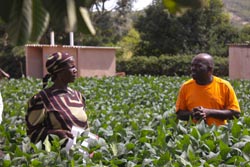 |
|
3 |
| N2Africa key facts 2015 and learnings 2016 |
 |
An overview of results achieved by N2Africa in 2015 and the issues to focus on in 2016.
Photo: Zambezi cruise. The plume of smoke in the centre is Victoria Falls or the Mosi-oa-Tunya (The smoke that thunders)
|
|
4 |
| N2Africa visiting the inoculant factory in Zimbabwe |
|
During the N2Africa Field Visits 2016 in Zimbabwe, we visited the inoculant factory in Marondera. The Soil Productivity Research Laboratory (SPRL) in Marondera, Zimbabwe hosts the government-owned inoculant factory of Zimbabwe. It is the sole facility in the country ...
Photo: Production of inoculant at the SPRL Inoculant factory in Marondera, Zimbabwe
|
 |
|
5 |
| N2Africa agronomy trials and farmers’ recommendations in Tanzania |
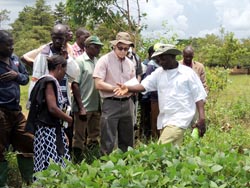 |
"Can the use of soyabean inoculants reduce the use of nitrogen fertilizers? How much fertilizer should soyabean farmers continue to apply in subsequent seasons? What are the long term effects of fertilizers, inoculants and soyabean and maize intercropping? N2Africa tries to find out," said Freddy Baijukya, Country Coordinator for N2Africa in Tanzania. ...
Photo: Joseph Mompesh showing the soyabean field trials
|
|
6 |
| Improving traditional storage systems of grain legume residues for livestock feeding in Ghana |
|
Crop residues are an important livestock feed resource and as such they are linking crop and animal production in West Africa. They are the second largest feed source for livestock after grazing, especially in the dry season in the savannas. ...
Photo: Evaluation of stored GLRs after two months of storage by animals (sheep)
|
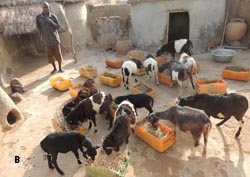
|
|
7 |
| School Feeding Program in Ghana - Caterers and cooks enriching school meals with soyabean recipes |
|
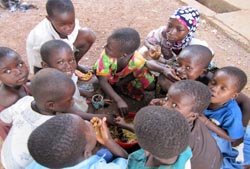
|
Soyabean is one of the most promising grain legume crops for improving both human and livestock nutrition in northern Ghana due to its high protein content. Although the crop has been promoted during the past decade by the Ministry of Food and Agriculture, amongst others, it is rarely consumed by households. This is mainly due to inadequate skills and knowledge in its processing and utilization. ...
Photo: School children enjoying some of the recipes at one of the training venues
|
|
8 |
| Women’s position, dietary nutrient adequacy and nutritional status of children in Ghana |
|
The prevalence of malnutrition in terms of stunting and wasting is high in rural Northern Ghana. Agriculture plays an important role in access to food, as agriculture represents the population’s main livelihood activity in the area. Hence, multiple programs (including N2Africa) aim to address malnutrition by increasing agricultural production. ...
Photo: Froukje interviewing female key stakeholders in Ghana (Photo Sofia Argyropoulou, 2015)
|
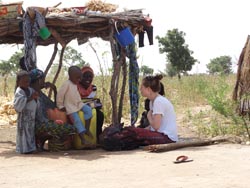 |
|
9 |
| The association between the diversity of crop production and nutritional indicators of rural households in Ghana |
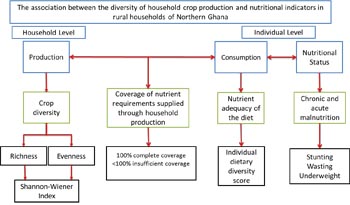 |
We investigated how household production diversity is correlated with dietary diversity and nutrition of infants and young children living in rural farming communities in northern Ghana. ...
Figure left: The study design shows how indicators are linked to production and consumption (Argyropoulou. 2015)
|
|
10 |
| An erratum of sorts |
|
In Podcaster 34 of last year, we reported on progress on our data flows. As an example of how fast data turnover enables timely learning, we presented results of a 2015 climbing bean diagnostic trial in Uganda. After seeing the results, the Uganda team kindly pointed out that the data used for the analysis contained an error ...
Graph showing mean yields for different treatments per district in the same diagnostic trial in Uganda
|
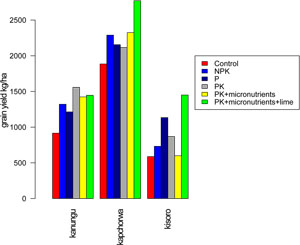 |
|
11 |
| N2Africa in the news |
The IITA Bulletin 2319 published articles how N2Africa helps farmers in Nigeria and Borno State gain access to markets and agro inputs...
Ken Giller of Wageningen University gave a presentatoin at the American Association for the Advancement of Science meeting in Washington in February. He was interviewed by a journalist, Alison Takemura and the interview was posted on the blog "The Plate" of National Geographic. ...
|
12 |
| Related publications |
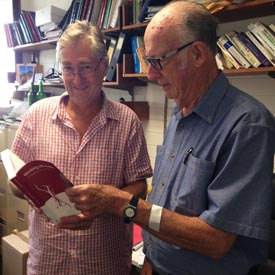 |
Centre for Rhizobium Studies published manual "Working with Rhizobia".
The nitrogen-fixing symbiosis between legumes and soil bacteria (known as rhizobia) is fundamental to sustainable agriculture. ... (Photo: the editors admiring the new publication)
ESRC - DFID Project: Assessing the impact of agricultural extension and input subsidies in Eastern DRC
Researchers from the Development Economics Group at Wageningen University teamed up with the N2Africa program to assess the impact of their program in Eastern DRC. First reports are available via the N2Africa website. ...
|
|
14 |
| Reports and other output uploaded on the N2Africa website |
Annual reports 2015 for DR Congo, Rwanda and Malawi.
The report written by CropLife for N2Africa about the assessment of contract sprayers in Borno State, Nigeria. See also the article in the previous Podcaster.
|
15 |
| Related newsletters |
Tropical Legumes III aims to improve the livelihoods of smallholder farmers in drought-prone areas of the two regions through enhanced productivity and production of grain legumes. This bulletin ...
The March 2016 ADVANCE Newsletter, with articles on ADVANCE bringing together maize and soyabean value chain actors to network ...
|
16 |
| Announcements |
The 17th African Association of Biological Nitrogen Fixation (AABNF) conference ...
Update on the 12th European Nitrogen Fixation Conference ...
Conference "Transition and Local Development in Eastern DRC" ...
|
17 |












